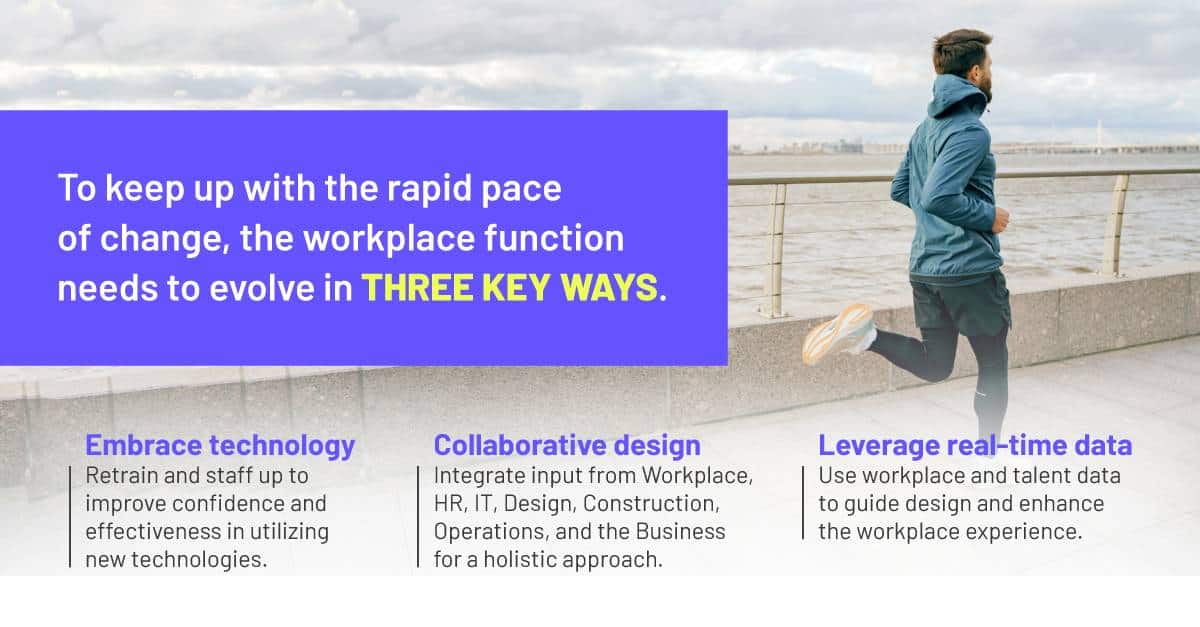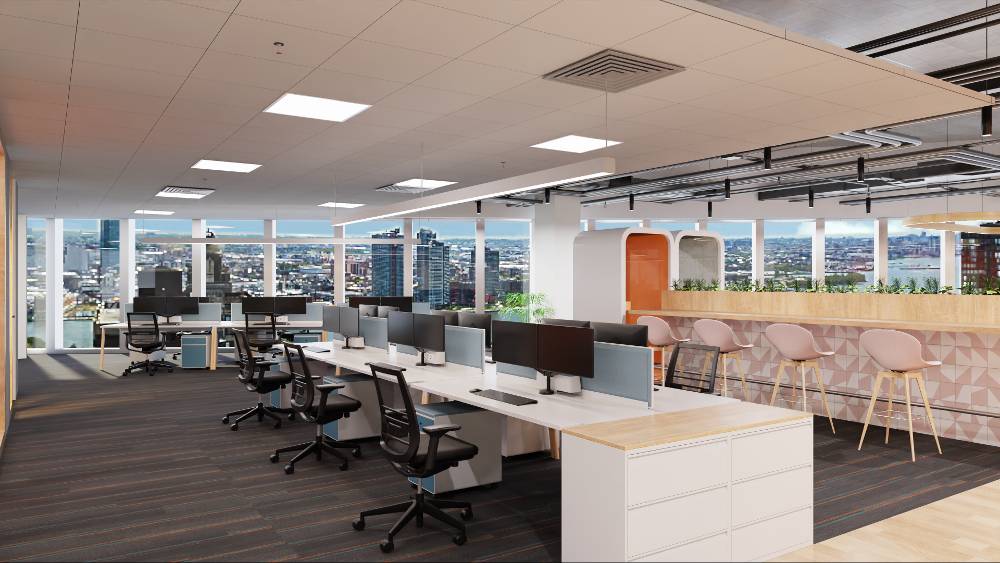As employees increasingly expect more from their office environments and AI continues to automate administrative and decision-making tasks, the modern enterprise faces mounting multidisciplinary demands, challenging workplace teams to adapt. In this blog, workplace strategist and thought leader Kevin Sauer delves into the essential skills and disciplines that workplace professionals need to stay relevant in the evolving landscape of the workplace.
Technological advancements and employee expectations are changing the modern office, and no workplace team wants to be left behind. How can they keep pace with evolving demands?
Workplace teams must address the skills and discipline gaps to effectively adapt to changing workplace dynamics. Adopting a more multidisciplinary approach by developing their technology proficiency, change management skills, and focusing on human-centered design thinking can help bridge these gaps.
In this blog post, I’ll discuss the challenges of traditional design methodologies and the technological skills and knowledge workplace professionals need to thrive in modern enterprises.
Improving the workplace implementation process
The traditional workplace implementation process (simplified and excluding site selection) typically involves a discovery phase to capture project requirements. These requirements are converted into static design guidelines and supplemented with project-specific needs. These documents guide design development and documentation, which are subsequently sent out for pricing. If the budget is exceeded, the project is value engineered, often by removing the “fun bits.”
At this point it’s off to permitting, then construction. Once construction is complete, the facility is handed over to operations to prepare the space for occupancy. Employees are then welcomed into their new workplace, with varying reactions based on the degree to which they were included in the overall process.
In short, the process is lengthy, sequential (workplace – design – construction – operations), and often relies on best practices from the past. Meanwhile, critical business processes and technology are evolving rapidly (e.g., AI computing power doubling every six months, much faster than Moore’s Law), likely requiring workplace changes from day one.

These changes will help workplace teams stay ahead of the curve, ensuring that office environments are flexible, responsive, and equipped to meet the demands of a rapidly changing technological landscape.
1. Embracing technology: Transforming workplace design with AI and digital innovation
To stay relevant and avoid obsolescence, workplace teams must embrace AI-lead workplace design technology to elevate their expertise to meet the demands of a modern workplace.
A prime example of an AI-led design innovation leader is Zaha Hadid Architects. Arjun Kaicker, Co-Head of Zaha Hadid Analytics + Insights, recently shared on LinkedIn that “since the inception of ZHAI in 2015, we’ve embarked on a remarkable journey to harness the transformative power of AI to reinvent workplace design. From leveraging AI for enhanced environmental performance to creating self-evolving spaces that can predictively respond to our rapidly changing workplace needs, we are at the cusp of a new design revolution.” The result is a truly unique, optimized, and awe-inspiring workspace.
Another trailblazer in workplace design technology is Shagufta Anurag, Founder of Saltmine. The Saltmine platform is an intelligent spatial database that digitally captures all of your real estate assets, empowering workplace teams to evolve their workplace experience in a unified platform.
From workplace data, to fully rendered 3D floorplans, to workplace applications, everything related to your portfolio lives under one intuitive digital model, eliminating multiple point solutions. It’s the best commercial platform I’ve seen for developing a digital twin of your workplace portfolio.
One of my favorite features of the platform is the ability to design and price a workplace as a fully rendered 3D model. The concept is simple: instead of documenting common space types for an architect to redraw later, you create a library of completely rendered 3D space type models, much like furniture manufacturers do.

For example, consider a medium-sized conference room. The 3D model includes walls, ceilings, floors, furniture, technology, and other components, all digitally editable, so you can change furniture, materials, and colors on the fly. The system also tracks historical pricing, so each time you add a space to the floorplan, it records a price, much like a shopping cart. You can quickly design a budget-friendly, fully rendered 3D floorplan and then take a virtual tour to see how it feels.
Digital workplace design solutions are evolving rapidly, fueled in part by AI, machine learning, and the recent rise in data collection and insights gained from occupancy sensors, indoor environmental sensors, and IoT devices. This technological evolution is transforming how we approach workplace design, making it more dynamic, responsive, and tailored to the needs of modern enterprises.
2. Collaborative design: A holistic approach for the modern workplace
In these dynamic times, cross-functional teams with a shared purpose are essential for redefining the workplace to support the evolving needs of employees and businesses.
During the pandemic, an interesting phenomenon occurred. Leaders from Workplace, HR, IT, Operations, EH&S, and Business units came together to tackle a critical issue: maintaining business operations while ensuring employee health and safety worldwide. Silos were dismantled, allowing everyone to share their perspectives and challenge one another in a collaborative environment.
The results were remarkable—barriers and biases were broken down, innovative solutions emerged, and a positive momentum was created. It was reminiscent of a chapter from Jim Collins’ book, Good to Great:

“Good to great comes about by a cumulative process—step by step, action by action, decision by decision, turn by turn of the flywheel—that adds up to sustained and spectacular results.”
This collaborative spirit flourished during the pandemic, but as it subsided, we retreated back into our silos, struggling to adapt to a hybrid work model.
Corporate functions exist to eliminate barriers and provide resources to ensure the core business can thrive. Reclaiming this cross-functional collaboration is crucial for future success, and the workplace team has a pivotal role in this equation.
To foster this collaboration, workplace teams must integrate input from various departments—Workplace, HR, IT, Design, Construction, Operations, and Business leaders—for a holistic approach. This integration leads to more innovative and effective solutions that support both employees and the business in the long run. By breaking down silos and working together, businesses can adapt to new challenges and create a more resilient, dynamic, and supportive workplace environment.
3. Leverage real-time data: Guiding design and enhancing the workplace experience
In recent years, the ability to collect and analyze workplace and workforce data at scale has dramatically improved.
Traditionally, workplace teams used local badge data, space occupancy samples, surveys, and interviews to gain insights, informing workplace pilots and new office environments. This slow, iterative process was followed by post-occupancy studies to evaluate success and guide future projects.
Today, dedicated workplace analytics teams leverage global badge swipe data, real-time occupancy sensors, and environmental data. They gather qualitative data from surveys and compare it against global industry benchmarks. AI, machine learning, and large language models help quickly identify patterns and trends to inform workplace performance and critical portfolio decisions.
New tools delve deeper into the physical and psychological aspects of work. For example, Shape has developed a survey tool that measures the fundamentals of flourishing, combining statistical and behavioral sciences to assess individual, team, and company well-being.
Three aspects of Shape immediately caught my attention:
- Comprehensive questions: Despite the survey’s length, taking over 30 minutes to complete, their response rate averages over 95%, which is truly remarkable compared to typical workplace survey response rates of 30%-50%.
- In-depth questions: The survey covers 12 science-based elements, with questions about you, the people around you, the workspace, and the company. The questions are complex, personal, and probing.
- Actionable results: Upon submission, respondents receive a personalized report with actions they can take to “flourish” at work. The company receives an anonymized report with actionable insights to improve the overall workplace environment.
It’s exciting to see how much we are collectively learning about people, work practices and the workplace. However, as IBM programmer George Fuechsel famously stated, “garbage in, garbage out.” Clearly understanding what you are trying to measure and why is crucial to ensuring data is collected, transformed, and analyzed correctly to avoid false insights.
By leveraging real-time data and advanced analytics, workplace teams can create more responsive, dynamic, and effective work environments that meet the evolving needs of employees and businesses alike.
Conclusion
The modern enterprise faces a crossroads where technology and evolving employee expectations are reshaping workplaces. To thrive, workplace teams must embrace technology, foster collaboration, and leverage real-time data.
Traditional approaches are insufficient against rapid technological changes and dynamic workforce needs. Leaders like Zaha Hadid Architects and Saltmine use AI-driven design and integrated digital solutions to transform workplace environments.
Success requires breaking down silos and fostering collaboration across Workplace, HR, IT, Design, Construction, Operations, and Business leaders. This collaborative spirit, crucial during the pandemic, must continue to drive innovation and resilience.
Leveraging real-time data and advanced analytics provides insights into workplace performance and employee well-being. Tools like Shape combine qualitative and quantitative data to foster thriving work environments.
In conclusion, the evolving role of workplace teams requires a continuous commitment to learning, adaptation, and collaboration. By embracing new technologies, fostering cross-functional teamwork, and utilizing data-driven insights, workplace professionals can create flexible, responsive, and effective environments that support the ever-changing demands of modern enterprises. As the landscape of work continues to evolve, these strategies will be essential for staying ahead and ensuring long-term success.
For more on the topic of changing skills workplace teams must acquire, check out my good friend Martin Byrne’s blog post “AI Isn’t Coming for Your Job, Peers Who Use AI Are.”
About the author
Kevin Sauer is a workplace strategist and thought leader with 20+ years of global experience in workplace strategy, corporate real estate, architecture, design, and workplace technology. His passion and expertise lie in partnering with diverse subject matter experts to uncover the relationships between culture, behavior, technology, organizational processes and the creation and use of physical and digital environments—in particular places for work, innovation, and learning. Kevin’s journey has been marked by a passionate dedication to cultivating workplaces that are more than just physical spaces; they are the embodiment of culture, creativity, and productivity, designed to echo the values and aspirations of their users. He has developed high-performing workplace teams, created workplace strategy programs, and designed and built more than 100 projects in 30+ countries for Fortune 100 companies including: Microsoft, HP, GE, and Amazon, transforming business practices, creating workspaces, and improving the employee experience.
Enjoying our blog? Be sure to subscribe to stay up-to-date on Saltmine's original content with the form below!


